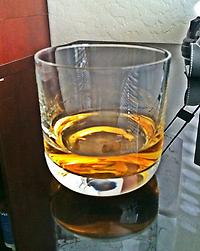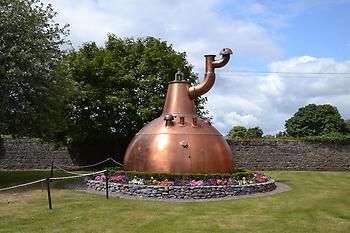Irish whiskey#
byElisabeth Ertl, 2015
"Whiskey" originally means "water of life", "uisce beatha" or "uisge beatha" in Gaelic. A legal definition of "Irish whiskey" exists since the Irish Whiskey Act of 1980, which states that Irish whiskey must be distilled and aged on the island of Ireland, including Northern Ireland. Furthermore the spirit must be aged for at least three years in wooden casks and must have an aroma and flavour derived from the materials which were used. Whiskey is to be produced from a yeast-fermented mash of cereal grains, which are distilled to an alcohol by volume level of less than 94,8%.
A difference between Irish whiskey and Scotch whisky is that most Irish whiskeys are distilled thrice, while Scotch whisky is distilled twice. The flavour varies between the two, as Irish whiskey has a smoother finish than the Scotch whisky, which has smoky, earthy overtones, because of the use of peat in the malting process. There are in fact some exemptions in both countries, like the Connemara peated Irish malt whiskey, which is only distilled twice.
One of the first distilled drinks in Europe was the Irish whiskey. The knowledge of distilling drinkable spirits is thought to be derived from the distillation of perfumes in the Mediterranean area, which was brought to Ireland by travelling Irish monks around 1000 AD. Irish whiskey was first mentioned in 1405, eighty-nine years prior to the first record in Scotland. Once Irish whiskey was the most popular spirit in the world, but since the late 19th century the sales quantity declined. As a result of this the number of distilleries in Ireland was reduced to only seven, of which only four have products which are sufficiently aged for sale and only one which was operating before 1975. Since 1990 the situation of the distilleries changed, as Irish whiskey developed into the fastest growing spirit of the world, with a growth rate of roughly twenty percent per year. This led to the construction of new distilleries as well as to the expansion of some older ones.
A distinction between several types of whiskey common to Ireland is made, for example "single pot still", "single malt", "single grain" and "blended" whiskey. Single pot still whiskey is made in a pot still from a mixture of malted and unmalted barley. A pot still is a single heated chamber with a vessel to collect the purified alcohol. In comparison, single malt too is made in a pot, but it contains only malted barley. Grain whiskey is continuously distilled from unmalted grains, the flavour is lighter and more neutral and therefore it is often used in blends and seldom found on its own.
Sources:
- Braun, R.-R., Irland, Michael Müller Verlag GmbH, Erlangen, 2012
- Wikipedia (cited 2014 Dec 22)




